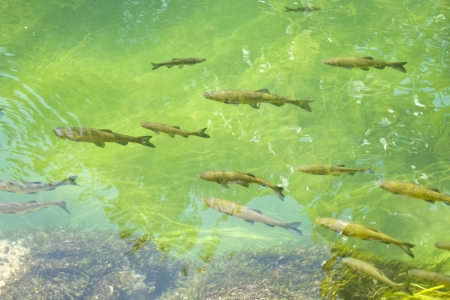1. Understanding the Nutritional Needs of Aquarium Fish
To keep your aquarium fish healthy and thriving, its essential to provide them with a well-balanced diet. Just like humans, fish require a variety of nutrients to support their growth, immune system, and overall well-being. The key nutrients that fish need include proteins, fats, vitamins, and minerals.
Proteins: Essential for Growth and Development
Protein is one of the most important nutrients for fish, as it helps with muscle development and overall growth. Carnivorous fish, such as bettas and cichlids, require a high-protein diet, while herbivorous species, like goldfish and certain types of catfish, need less protein but more plant-based nutrients.
Fats: Providing Energy
Fats serve as an energy source for fish and help maintain healthy cell function. Omega-3 and omega-6 fatty acids are particularly beneficial for maintaining vibrant colors and supporting reproductive health. However, too much fat can be harmful, so its important to choose foods with balanced fat content.
Vitamins: Supporting Immune Health
Vitamins play a crucial role in keeping fish healthy. For example:
- Vitamin A: Supports vision and immune health.
- Vitamin C: Helps with wound healing and disease resistance.
- Vitamin D: Aids in calcium absorption for strong bones.
- B Vitamins: Assist with metabolism and energy production.
Minerals: Strengthening Bones and Scales
Fish absorb many minerals directly from the water, but some must come from their diet. Important minerals include:
| Mineral | Function |
|---|---|
| Calcium | Essential for bone strength and proper nerve function. |
| Iodine | Aids in thyroid function and metabolism regulation. |
| Zinc | Supports immune health and enzyme production. |
| Iron | Necessary for oxygen transport in the bloodstream. |
The Importance of a Balanced Diet
No single type of food contains all the necessary nutrients for every species of fish. To ensure optimal health, its best to provide a varied diet that includes flakes, pellets, frozen foods, and live foods as appropriate for your fish type. Paying attention to their specific dietary needs will help keep your aquarium inhabitants happy and healthy.
2. Best Fish Food for Tropical Fish
Tropical fish like guppies, tetras, and bettas are some of the most popular aquarium species. To keep them healthy and vibrant, its essential to provide a well-balanced diet that meets their nutritional needs. There are several types of food available, including flakes, pellets, and freeze-dried options.
Flake Food
Flake food is a common choice for tropical fish because it is easy to eat and provides balanced nutrition. It works well for surface-feeding fish like guppies and tetras.
Pellet Food
Pellets come in various sizes and sink at different rates, making them ideal for mid-level or bottom-feeding tropical fish. Bettas, for example, often prefer floating pellets designed specifically for them.
Freeze-Dried Food
Freeze-dried foods such as bloodworms and brine shrimp offer high protein content and are excellent treats for tropical fish. These foods help mimic their natural diet while adding variety to their meals.
Comparison of Fish Food Types
| Food Type | Benefits | Best For |
|---|---|---|
| Flake Food | Easy to digest, provides balanced nutrition | Tetras, guppies |
| Pellet Food | Sinks at different rates, available in various sizes | Bettas, mid-level feeders |
| Freeze-Dried Food | High in protein, mimics natural diet | Bettas, guppies, carnivorous fish |
Selecting the right food type depends on your fish’s species and feeding habits. A combination of flakes, pellets, and freeze-dried treats can help ensure a well-rounded diet.
![]()
3. Feeding Solutions for Bottom Feeders and Algae Eaters
Bottom-dwelling fish like catfish, plecos, and loaches require specialized food that sinks to the bottom of the tank. Unlike surface feeders, these species rely on sinking pellets, wafers, and fresh foods to meet their dietary needs. Choosing the right food ensures they stay healthy and active.
Best Food Options for Bottom Feeders
Bottom feeders thrive on a variety of sinking foods that mimic their natural diet. Here are some of the best options:
| Food Type | Best For | Benefits |
|---|---|---|
| Sinking Pellets | Corydoras, Loaches, Catfish | Nutrient-rich and easy to digest |
| Algae Wafers | Plecos, Otocinclus, Snails | Provides essential plant-based nutrition |
| Fresh Vegetables (Zucchini, Cucumber) | Plecos, Gold Nugget Catfish | A natural source of fiber and vitamins |
| Bloodworms & Brine Shrimp | Corydoras, Kuhli Loaches | A protein boost for growth and energy |
Sinking Pellets vs. Wafers: Which One to Choose?
Sinking pellets are small and designed for fish that scavenge along the substrate. They work well for species like corydoras and smaller loaches. On the other hand, algae wafers are larger and more compact, making them ideal for plecos and other algae eaters that need a steady food source.
Sinking Pellets Pros:
- Easier for small bottom feeders to consume
- Dissolves slowly to prevent water cloudiness
- A balanced mix of protein and plant nutrients
Sinking Wafers Pros:
- Larger size makes them last longer in the tank
- Irritates less aggressive competition among fish
- Mimics natural grazing behavior for algae eaters
The Importance of Fresh Foods for Bottom Feeders
Addition of fresh vegetables like zucchini or cucumber can significantly improve digestion and overall health. Blanching vegetables before adding them to the tank makes them softer and easier to eat. Some bottom feeders also enjoy occasional treats like shelled peas or sweet potatoes.
Tips for Feeding Bottom-Dwelling Fish
- Avoid Overfeeding: Since bottom feeders often scavenge throughout the day, offer food in small amounts to prevent waste buildup.
- Create a Feeding Schedule: Feed at night if your fish are nocturnal, such as plecos or kuhli loaches.
- Add Variety: Rotate between pellets, wafers, and fresh veggies to ensure balanced nutrition.
- Use Feeding Clips: For fresh vegetables, using clips can keep food in place and make it easier for fish to nibble.
- Cater to Specific Needs: Research your specific species’ diet requirements to provide tailored nutrition.
Selecting the right food for your bottom-dwelling fish ensures they remain healthy while keeping your aquarium clean. By offering a mix of sinking pellets, algae wafers, and fresh vegetables, you can support their natural feeding habits while enhancing their well-being.
4. Specialty Diets for Carnivorous and Herbivorous Fish
Different types of aquarium fish have unique dietary needs based on their natural feeding habits. Carnivorous fish, such as cichlids, thrive on a protein-rich diet, while herbivorous species, like goldfish, require plant-based nutrition. Understanding these differences will help you choose the best food to keep your fish healthy and vibrant.
Carnivorous Fish: High-Protein Diets
Carnivorous fish are predators that primarily feed on other animals in the wild. They need a diet rich in protein to support muscle growth and energy levels. Here are some recommended food options for carnivorous fish:
| Food Type | Description |
|---|---|
| Live Foods | Includes brine shrimp, bloodworms, and small feeder fish; great for stimulating natural hunting instincts. |
| Frozen Foods | A convenient alternative to live foods; retains high protein content while reducing disease risk. |
| Pellets and Flakes | Specialized formulas with high protein content; ideal for daily feeding. |
| Dried Insects & Shrimp | A nutritious treat that adds variety to their diet. |
Herbivorous Fish: Plant-Based Nutrition
Herbivorous fish rely on plant matter as their primary food source. Feeding them a fiber-rich, plant-based diet helps maintain proper digestion and overall health. Below are some excellent food choices for herbivorous fish:
| Food Type | Description |
|---|---|
| Algae Wafers | A staple food for herbivores, packed with essential nutrients and fiber. |
| Blanched Vegetables | Zucchini, spinach, and lettuce can be fed in small portions as fresh supplements. |
| Pellets & Flakes (Vegetable-Based) | A formulated option containing spirulina and other plant nutrients. |
| Nori (Dried Seaweed) | A great source of natural vitamins for herbivorous fish like goldfish and plecos. |
Tips for Feeding Carnivorous and Herbivorous Fish
- Avoid Overfeeding: Feed only the amount your fish can consume within a few minutes to prevent water contamination.
- Diversify Their Diet: Offering a variety of foods ensures balanced nutrition and mimics their natural feeding habits.
- Select High-Quality Food: Look for reputable brands with minimal fillers to provide optimal nutrition.
- Mimic Natural Feeding Patterns:Carnivores may benefit from occasional fasting days, while herbivores should have frequent small meals.
Catering to the specific dietary needs of your carnivorous or herbivorous fish will help them thrive in your aquarium. Providing the right balance of nutrients ensures their health, longevity, and vibrant coloration.
5. Choosing Between Live, Frozen, and Prepared Fish Foods
When it comes to feeding your aquarium fish, there are three main types of food to consider: live, frozen, and prepared (flakes, pellets, or granules). Each type has its advantages and disadvantages, depending on the species of fish you have and your level of commitment to their care.
Live Fish Food
Live foods like brine shrimp, daphnia, and bloodworms are excellent sources of protein and closely mimic what fish eat in the wild. They help stimulate natural hunting behaviors and can be beneficial for certain species that require a high-protein diet.
Pros:
- Highly nutritious and fresh
- Encourages natural feeding behavior
- Great for carnivorous and picky eaters
Cons:
- More expensive than other options
- Poor handling can introduce parasites or diseases
- Requires proper storage and maintenance
Frozen Fish Food
Frozen foods offer similar benefits to live food but with better convenience and safety. These foods are typically flash-frozen to preserve nutrients while eliminating parasites or bacteria that may harm your fish.
Pros:
- Nutrient-rich and safer than live food
- Easier to store with a long shelf life
- A wide variety is available (shrimp, worms, krill, etc.)
Cons:
- Slightly more expensive than dry food
- Takes time to thaw before feeding
- Might cloud the water if overfed
Prepared Fish Food (Flakes, Pellets, Granules)
This category includes processed foods such as flakes, pellets, and granules. They are formulated to provide balanced nutrition for various types of fish and are the most commonly used option among aquarium hobbyists.
| Type | Description | Best For |
|---|---|---|
| Flakes | Easily digestible; ideal for surface feeders. | Tetras, guppies, bettas |
| Pellets | Dense nutrition; available in sinking or floating varieties. | Cichlids, goldfish, angelfish |
| Granules | Sinks slowly; good for mid-water feeders. | Tetras, barbs, gouramis |
Pros:
- Easiest to store and use
- A wide range of formulas for different species
- No risk of introducing parasites or bacteria
Cons:
- Nutrients degrade over time once opened
- Might not be as appealing to some fish compared to live or frozen food
- Poor-quality brands may contain fillers instead of essential nutrients
Which Type of Food Is Best for Your Fish?
The best choice depends on your fish species and their dietary needs. Carnivorous fish often thrive on a mix of live or frozen food, while omnivores and herbivores can do well with high-quality pellets or flakes. A varied diet that includes different types of food will ensure optimal health and coloration.


